The global train antenna market is valued at USD 1,094.9 million in 2025 and is set to reach USD 1,817.7 million by 2035, recording an absolute increase of USD 722.8 million over the forecast period. This translates into a total growth of 66.1%, with the market forecast to expand at a compound annual growth rate (CAGR) of 5.2% between 2025 and 2035. The overall market size is expected to grow by approximately 1.7X during the same period, supported by increasing adoption of advanced communication technologies in rail transportation, growing demand for passenger connectivity solutions, and rising requirements for real-time train monitoring and control systems across passenger, freight, and high-speed rail networks.
The global train antenna market represents a rapidly evolving segment within the railway communication infrastructure industry, driven by increasing digitalization of rail operations and growing passenger expectations for seamless connectivity during travel. Train antennas serve as critical components for establishing reliable communication links between trains and ground-based infrastructure, enabling essential functions such as positive train control, passenger internet services, crew communication, and real-time operational data transmission. The integration of these communication systems has become increasingly vital for ensuring operational safety, enhancing passenger experience, and optimizing railway network efficiency.
The market encompasses various antenna technologies designed for railway applications, including long-wave antennas for extended range communications, medium-wave antennas for standard operational requirements, and short-wave antennas for high-frequency data transmission. Modern train antenna systems incorporate advanced technologies such as MIMO (Multiple-Input Multiple-Output) configurations, beamforming capabilities, and multi-band functionality to support simultaneous voice, data, and video communications. The evolution toward smart railways and autonomous train operations has further accelerated the demand for sophisticated antenna systems capable of handling high-bandwidth applications and ensuring uninterrupted connectivity across diverse geographical terrains.
Market dynamics are significantly influenced by ongoing railway modernization projects worldwide, particularly in developing economies where governments are investing heavily in rail infrastructure expansion and technology upgrades. The shift toward electric and high-speed rail systems has created substantial demand for advanced antenna solutions capable of maintaining reliable communications at elevated speeds and in challenging electromagnetic environments. Additionally, the growing emphasis on passenger experience and the integration of Internet of Things (IoT) technologies in railway operations are driving the adoption of multi-functional antenna systems that can support diverse communication protocols simultaneously.
The competitive landscape is characterized by continuous technological innovation, with manufacturers focusing on developing compact, weather-resistant antenna solutions that can withstand the harsh operating conditions typical in railway environments. Market participants are increasingly emphasizing the development of integrated antenna systems that combine multiple communication functions into single units, reducing installation complexity and maintenance requirements while improving overall system reliability and performance.
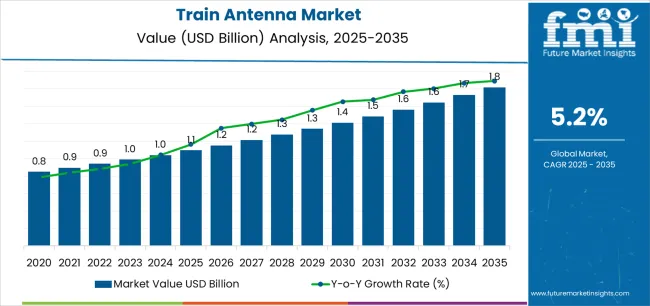
Between 2025 and 2030, the train antenna market is projected to expand from USD 1,094.9 million to USD 1,410.7 million, resulting in a value increase of USD 315.8 million, which represents 43.7% of the total forecast growth for the decade. This phase of development will be shaped by increasing deployment of 5G communication technologies in railway networks, rising adoption of Internet of Things (IoT) applications for predictive maintenance, and growing implementation of passenger entertainment systems requiring high-bandwidth connectivity across conventional and high-speed rail services.
Between 2030 and 2035, the market is forecast to grow from USD 1,410.7 million to USD 1,817.7 million, adding another USD 407.0 million, which constitutes 56.3% of the overall ten-year expansion. This period is expected to be characterized by the advancement of autonomous train control systems, the development of integrated communication platforms for smart city connectivity, and the expansion of real-time passenger information systems across diverse railway applications. The growing emphasis on operational efficiency and predictive analytics will drive demand for advanced antenna varieties with enhanced signal processing capabilities, improved multi-band performance characteristics, and superior environmental resilience profiles.
Between 2020 and 2024, the train antenna market experienced steady growth, driven by increasing railway electrification projects and growing recognition of communication infrastructure importance following extensive digitalization initiatives in the transportation sector. The market developed as railway operators recognized the critical role of reliable communication systems in ensuring operational safety and began investing in comprehensive antenna solutions designed specifically for railway applications. Technological advancement in antenna design and signal processing began emphasizing the critical importance of maintaining communication reliability while enhancing system integration and improving operational efficiency across diverse railway network configurations.
| Metric | Value |
|---|---|
| Estimated Value in (2025E) | USD 1,094.9 million |
| Forecast Value in (2035F) | USD 1,817.7 million |
| Forecast CAGR (2025 to 2035) | 5.2% |
From 2030 to 2035, the market is forecast to grow from USD 1,410.7 million to USD 1,817.7 million, adding another USD 407.0 million, which constitutes 56.3% of the overall ten-year expansion. This period is expected to be characterized by the advancement of artificial intelligence integration in railway communication systems, the integration of predictive maintenance algorithms for optimal antenna performance monitoring, and the development of specialized communication solutions for high-speed rail environments. The growing emphasis on proactive operational management and network optimization will drive demand for premium varieties with enhanced real-time analytics capabilities, improved weather resistance options, and superior automated diagnostic characteristics.
Between 2020 and 2024, the train antenna market experienced robust growth, driven by increasing awareness of railway communication infrastructure requirements and growing recognition of advanced antenna systems' effectiveness in supporting reliable railway operations across passenger services and freight transportation networks. The market developed as operators recognized the potential for modern antenna solutions to deliver operational safety advantages while meeting contemporary requirements for comprehensive communication coverage and dependable signal transmission performance. Technological advancement in antenna engineering and communication protocols began emphasizing the critical importance of maintaining signal integrity while extending operational lifespan and improving system reliability across diverse railway communication applications.
Market expansion is being supported by the increasing global focus on railway infrastructure modernization and the corresponding shift toward high-performance communication systems that can provide superior connectivity characteristics while meeting operator requirements for comprehensive network management and cost-effective communication solutions. Modern railway operators are increasingly focused on incorporating antenna systems that can enhance operational safety while satisfying demands for consistent, precisely managed communication networks and optimized signal transmission practices. Train antennas' proven ability to deliver reliable communication excellence, operational efficiency improvement, and diverse application possibilities makes them essential components for forward-thinking railway operators and technology-focused transportation professionals.
The growing emphasis on passenger experience enhancement and operational optimization is driving demand for high-performance train antenna systems that can support distinctive connectivity outcomes and comprehensive communication management across high-speed rail projects, urban transit applications, and premium passenger services. Operator preference for communication systems that combine functional excellence with operational reliability is creating opportunities for innovative implementations in both traditional and emerging railway communication applications. The rising influence of smart transportation technologies and advanced connectivity solutions is also contributing to increased adoption of specialized train antenna systems that can provide authentic performance benefits and reliable communication monitoring characteristics.
The market is segmented by type, application, frequency band, installation type, and region. By type, the market is divided into long-wave antennas, medium-wave antennas, and short-wave antennas. Based on application, the market is categorized into traditional train, high-speed train, metro/subway, and freight train. By frequency band, the market includes VHF/UHF, cellular/LTE, Wi-Fi/Bluetooth, and satellite communication. By installation type, the market encompasses roof-mounted, side-mounted, and integrated systems. Regionally, the market is divided into North America, Europe, Asia Pacific, Latin America, Middle East & Africa, and other regions.
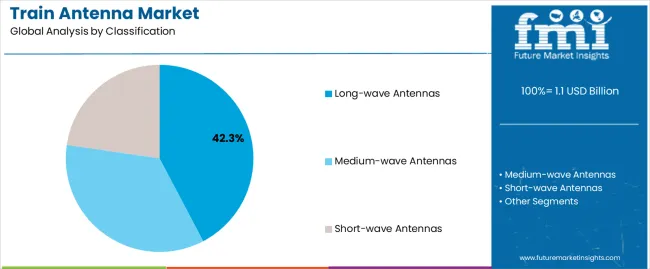
The long-wave antennas segment is projected to account for 42.3% of the train antenna market in 2025, reaffirming its position as the leading type category. Railway operators and communication professionals increasingly utilize long-wave systems for their superior long-range communication characteristics, established performance standards, and essential functionality in diverse railway applications across multiple network configurations. Long-wave antennas' proven performance characteristics and established reliability directly address operator requirements for dependable communication coverage and optimal signal precision in both urban and intercity railway applications.
This type segment forms the foundation of modern railway communication performance patterns, as it represents the technology category with the greatest coverage range potential and established compatibility across multiple railway communication systems. Operator investments in extended-range communication technology and coverage optimization continue to strengthen adoption among safety-conscious railway operators. With operators prioritizing communication consistency and signal reliability, long-wave systems align with both operational objectives and safety requirements, making them the central component of comprehensive railway communication strategies.
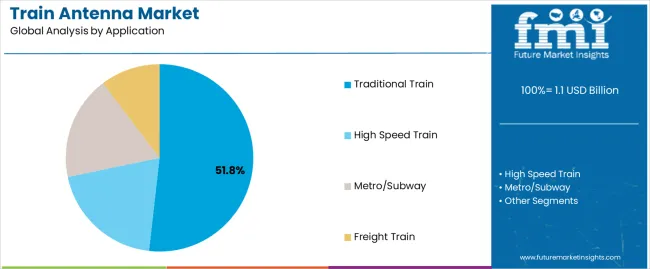
Traditional train is projected to represent 51.8% of the train antenna market in 2025, underscoring its critical role as the primary application for communication-focused operators seeking superior connectivity benefits and enhanced railway network management credentials. Railway operators and transportation authorities prefer traditional train applications for their established operational requirements, proven service demand, and ability to maintain exceptional communication quality while supporting versatile route coverage during diverse daily operational activities. Positioned as essential applications for safety-conscious operators, traditional train offerings provide both operational excellence and passenger service advantages.
The segment is supported by continuous improvement in railway communication technology and the widespread availability of established communication standards that enable operational assurance and premium positioning at the network level. Additionally, railway operators are optimizing antenna selections to support route-specific applications and comprehensive network communication strategies. As railway technology continues to advance and operators seek efficient communication methods, traditional train applications will continue to drive market growth while supporting operational reliability and railway network communication strategies.
The train antenna market is advancing rapidly due to increasing safety awareness regarding railway communication systems and growing need for specialized antenna solutions that emphasize superior signal performance across passenger segments and freight applications. However, the market faces challenges, including competition from alternative communication technologies, installation complexity requirements, and initial investment cost considerations affecting adoption rates. Innovation in smart antenna integration and advanced signal processing materials continues to influence market development and expansion patterns.
The growing adoption of train antennas with 5G connectivity and advanced communication integration is enabling railway operators to develop communication management strategies that provide distinctive bandwidth benefits while commanding automated operation and enhanced real-time data transmission characteristics. 5G applications provide superior connectivity consistency while allowing more sophisticated communication optimization features across various railway categories. Operators are increasingly recognizing the operational advantages of advanced connectivity positioning for comprehensive communication outcomes and technology-integrated railway network management.
Modern train antenna manufacturers are incorporating advanced signal monitoring sensors, real-time performance tracking capabilities, and automated diagnostic systems to enhance communication precision, improve operational reliability, and meet operator demands for intelligent communication management solutions. These systems improve operational effectiveness while enabling new applications, including continuous signal quality monitoring programs and predictive maintenance protocols. Advanced monitoring integration also allows operators to support proactive communication optimization positioning and performance assurance beyond traditional antenna operations.
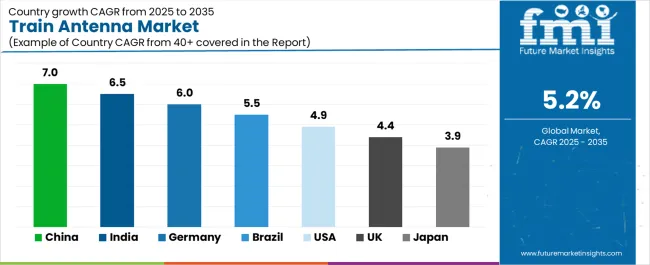
| Country | CAGR (2025-2035) |
|---|---|
| China | 7.0% |
| India | 6.5% |
| Germany | 6.0% |
| Brazil | 5.5% |
| USA | 4.9% |
| UK | 4.4% |
| Japan | 3.9% |
The train antenna market is experiencing robust growth globally, with China leading at a 7.0% CAGR through 2035, driven by the expanding high-speed rail network, growing urbanization requirements, and increasing adoption of advanced railway communication systems. India follows at 6.5%, supported by rising railway modernization projects, expanding passenger services, and growing acceptance of digital communication technologies. Germany shows growth at 6.0%, emphasizing established railway standards and comprehensive communication technology development. Brazil records 5.5%, focusing on urban transit development and connectivity enhancement. The USA demonstrates 4.9% growth, prioritizing advanced railway communication technologies and operational optimization.
The report covers an in-depth analysis of 40+ countries top-performing countries are highlighted below.
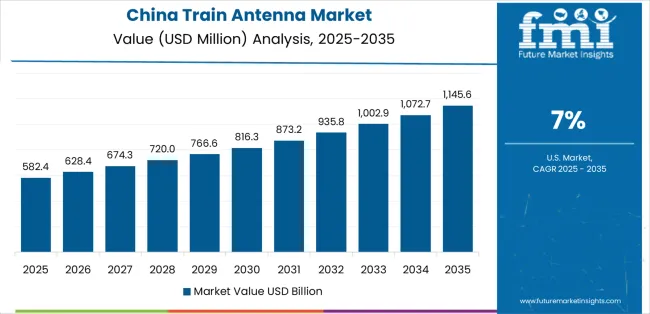
Revenue from train antenna consumption and sales in China is projected to exhibit exceptional growth with a CAGR of 7.0% through 2035, driven by the country's rapidly expanding high-speed rail network, favorable government policies toward railway infrastructure modernization, and initiatives promoting advanced communication technologies across major intercity corridors. China's position as a leading railway technology innovator and increasing focus on smart transportation systems are creating substantial demand for high-quality train antennas in both domestic and export markets. Major railway equipment companies and communication system providers are establishing comprehensive antenna manufacturing capabilities to serve growing demand and emerging connectivity opportunities.
Revenue from train antenna products in India is expanding at a CAGR of 6.5%, supported by rising railway modernization investment, growing connectivity consciousness, and expanding infrastructure development capabilities. The country's developing railway network and increasing operator investment in communication technologies are driving demand for train antennas across both traditional and modern railway applications. International railway equipment companies and domestic manufacturers are establishing comprehensive operational networks to address growing market demand for communication devices and efficient connectivity solutions.
Revenue from train antenna products in Germany is projected to grow at a CAGR of 6.0% through 2035, supported by the country's mature railway standards, established communication regulations, and leadership in transportation technology. Germany's sophisticated railway infrastructure and strong support for advanced communication systems are creating steady demand for both traditional and innovative train antenna varieties. Leading railway equipment manufacturers and specialty providers are establishing comprehensive operational strategies to serve both domestic markets and growing export opportunities.
Revenue from train antenna products in Brazil is projected to grow at a CAGR of 5.5% through 2035, driven by the country's emphasis on urban transit development, connectivity consciousness growth, and growing railway infrastructure capabilities. Brazilian operators and transportation authorities consistently seek communication-focused equipment that enhances network connectivity and supports operational excellence for both traditional and modern railway applications. The country's position as a Latin American transportation market leader continues to drive innovation in specialized railway communication applications and operator connectivity standards.
Revenue from train antenna products in the USA is projected to grow at a CAGR of 4.9% through 2035, supported by the country's emphasis on railway communication advancement, operational efficiency optimization, and advanced automation integration requiring efficient communication solutions. American operators and safety-conscious authorities prioritize performance reliability and communication precision, making specialized train antennas essential components for both traditional and modern railway communication applications. The country's comprehensive transportation technology leadership and advancing connectivity patterns support continued market expansion.
Revenue from train antenna products in the UK is projected to grow at a CAGR of 4.4% through 2035, supported by established communication standards, mature railway markets, and emphasis on connectivity reliability across passenger and freight sectors. British operators and communication professionals prioritize quality performance and operational consistency, creating steady demand for premium antenna solutions. The country's comprehensive market maturity and established communication practices support continued development in specialized applications.
Revenue from train antenna products in Japan is projected to grow at a CAGR of 3.9% through 2035, supported by the country's emphasis on precision manufacturing, operational excellence, and advanced technology integration requiring efficient communication solutions. Japanese operators and technology-focused authorities prioritize technical performance and manufacturing precision, making specialized train antennas essential components for both traditional and modern railway communication applications. The country's comprehensive transportation leadership and advancing connectivity patterns support continued market expansion.
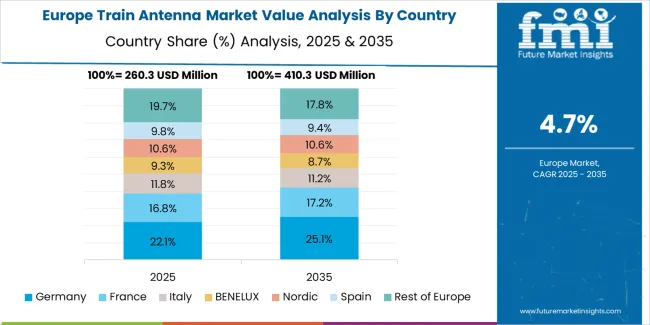
The Europe train antenna market is projected to grow from USD 312.4 million in 2025 to USD 503.8 million by 2035, recording a CAGR of 4.9% over the forecast period. Germany leads the region with a 38.2% share in 2025, moderating slightly to 37.6% by 2035, supported by its strong railway infrastructure and demand for premium, technologically advanced communication solutions. The United Kingdom follows with 26.1% in 2025, easing to 25.7% by 2035, driven by a mature railway network and emphasis on communication reliability and operational performance. France accounts for 17.3% in 2025, rising to 18.0% by 2035, reflecting steady adoption of advanced communication technologies and connectivity enhancement.
Italy holds 8.9% in 2025, expanding to 9.4% by 2035 as railway modernization and specialty communication applications grow. Spain contributes 5.2% in 2025, growing to 5.7% by 2035, supported by expanding high-speed rail development and communication infrastructure modernization. The Nordic countries rise from 2.9% in 2025 to 3.2% by 2035 on the back of strong technological advancement and advanced communication methodologies. BENELUX remains at 1.4% share across both 2025 and 2035, reflecting mature, technology-focused railway markets.
| Country | Primary Growth Driver | Supporting Factor |
|---|---|---|
| China | Expansion of high-speed rail corridors | Strong government funding and 5G-enabled smart train projects |
| India | Railway modernization and electrification | Digitalization of operations and Make-in-India manufacturing initiatives |
| Germany | Advanced communication infrastructure | Focus on safety standards and cross-border rail connectivity |
| Brazil | Urban transit and metro expansion | Public-private partnerships in smart mobility projects |
| USA | Integration of IoT and automation in trains | Federal investments in sustainable rail infrastructure |
| UK | Reliability-focused railway upgrades | Adoption of multi-band communication systems for passenger safety |
| Japan | Precision manufacturing and technology leadership | Continuous R&D in compact and multi-frequency antenna design |
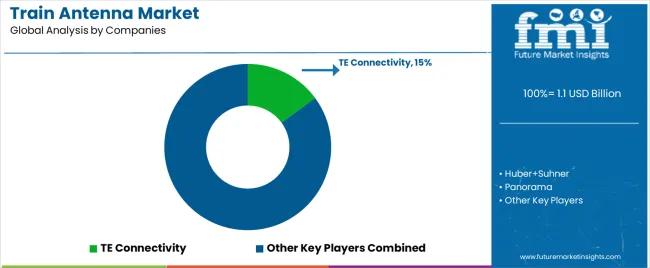
The train antenna market is characterized by competition among established communication equipment manufacturers, specialized railway technology companies, and integrated transportation solution providers. Companies are investing in advanced antenna technologies, specialized communication systems, product innovation capabilities, and comprehensive distribution networks to deliver consistent, high-quality, and reliable train antenna communication systems. Innovation in signal processing, frequency optimization, and railway-focused product development is central to strengthening market position and customer satisfaction.
TE Connectivity leads the market with a strong focus on communication technology innovation and comprehensive train antenna solutions, offering railway and transit systems with emphasis on performance excellence and technological heritage. Huber+Suhner provides specialized communication systems with a focus on European market applications and precision engineering networks. Panorama delivers integrated communication technology solutions with a focus on operator positioning and connectivity efficiency. Antonics specializes in comprehensive railway communication systems with an emphasis on operational applications. Round Solutions focuses on comprehensive railway connectivity with advanced design and premium positioning capabilities.
The success of train antennas in meeting railway communication demands, operational connectivity requirements, and technology integration will not only enhance transportation communication outcomes but also strengthen global railway technology manufacturing capabilities. It will consolidate emerging regions' positions as hubs for efficient communication equipment production and align advanced economies with comprehensive railway systems. This calls for a concerted effort by all stakeholders -- governments, industry bodies, manufacturers, distributors, and investors. Each can be a crucial enabler in preparing the market for its next phase of growth.
How Governments Could Spur Local Production and Adoption?
How Industry Bodies Could Support Market Development?
How Distributors and Railway Industry Players Could Strengthen the Ecosystem?
How Manufacturers Could Navigate the Shift?
| Items | Values |
|---|---|
| Quantitative Units (2025) | USD 1,094.9 million |
| Type | Long-wave Antennas, Medium-wave Antennas, Short-wave Antennas |
| Application | Traditional Train, High Speed Train, Metro/Subway, Freight Train |
| Frequency Band | VHF/UHF, Cellular/LTE, Wi-Fi/Bluetooth, Satellite Communication |
| Installation Type | Roof-mounted, Side-mounted, Integrated Systems |
| Regions Covered | North America, Europe, Asia Pacific, Latin America, Middle East & Africa, Other Regions |
| Countries Covered | China, India, Germany, Brazil, United States, United Kingdom, Japan, and 40+ countries |
| Key Companies Profiled | TE Connectivity, Huber+Suhner, Panorama, Antonics, Round Solutions, and other leading train antenna companies |
| Additional Attributes | Dollar sales by type, application, frequency band, installation type, and region; regional demand trends, competitive landscape, technological advancements in antenna engineering, precision communication initiatives, railway connectivity enhancement programs, and premium product development strategies |
The global train antenna market is estimated to be valued at USD 1.1 billion in 2025.
The market size for the train antenna market is projected to reach USD 1.8 billion by 2035.
The train antenna market is expected to grow at a 5.2% CAGR between 2025 and 2035.
The key product types in train antenna market are long-wave antennas, medium-wave antennas and short-wave antennas.
In terms of application, traditional train segment to command 51.8% share in the train antenna market in 2025.






Full Research Suite comprises of:
Market outlook & trends analysis
Interviews & case studies
Strategic recommendations
Vendor profiles & capabilities analysis
5-year forecasts
8 regions and 60+ country-level data splits
Market segment data splits
12 months of continuous data updates
DELIVERED AS:
PDF EXCEL ONLINE
Train Control and Management Systems Market Size and Share Forecast Outlook 2025 to 2035
Train Dispatching Market Size and Share Forecast Outlook 2025 to 2035
Train Loaders Market Size and Share Forecast Outlook 2025 to 2035
Train Contactor Market - Growth & Demand 2025 to 2035
Training Shoes Market Analysis - Size, Trends & Forecast 2025 to 2035
Train Seat Market Growth – Trends & Forecast 2025 to 2035
Train Battery Market Growth - Trends & Forecast 2024 to 2034
Train Transformer Market
Train Auxiliary Rectifier Market
Train Ceiling Modules Market
Train Bogie Market
Strain Clamp Market Size and Share Forecast Outlook 2025 to 2035
Dog Training Equipment Market Size and Share Forecast Outlook 2025 to 2035
Golf Training Aids Market Analysis by Growth, Trends and Forecast from 2025 to 2035
Gait Trainer Market Growth - Trends, Demand & Forecast 2025 to 2035
Air Entrainment Meters for Mortar Market Size and Share Forecast Outlook 2025 to 2035
Sales Training and Onboarding Software Market Size and Share Forecast Outlook 2025 to 2035
Potty Training and Step Stools Market Size and Share Forecast Outlook 2025 to 2035
Cross Training Shoes Market Size and Share Forecast Outlook 2025 to 2035
Multistrain Probiotics Market Analysis - Size, Share, and Forecast Outlook 2025 to 2035

Thank you!
You will receive an email from our Business Development Manager. Please be sure to check your SPAM/JUNK folder too.
Chat With
MaRIA